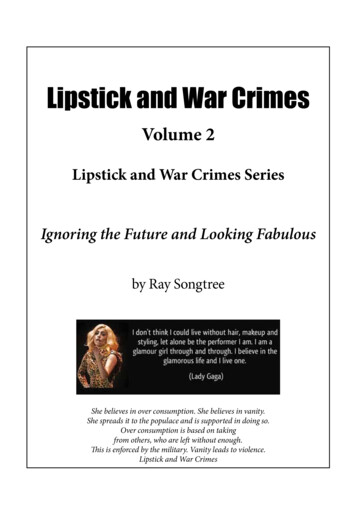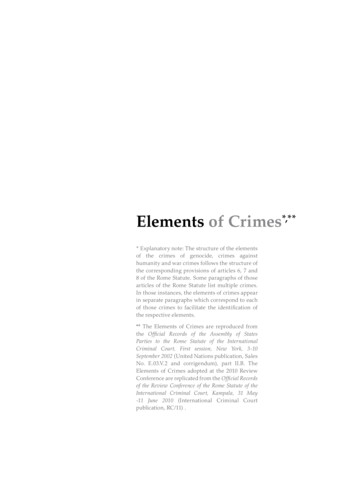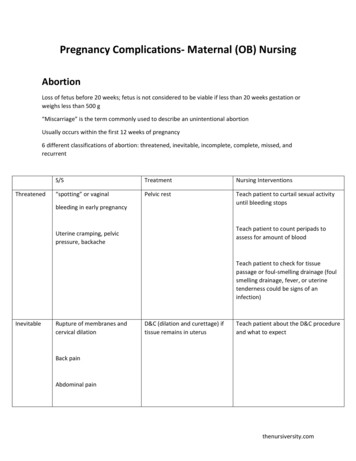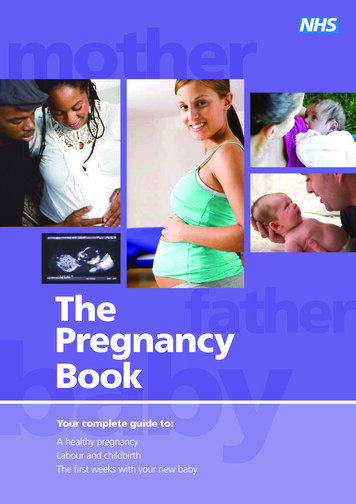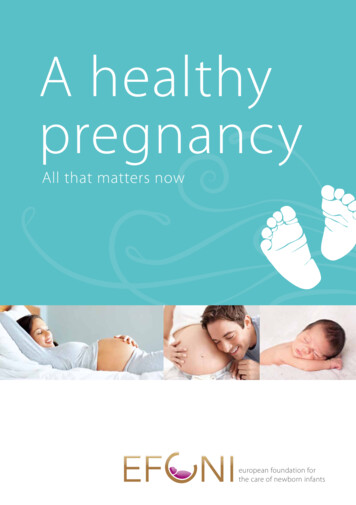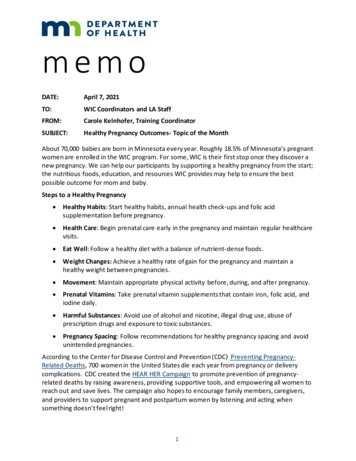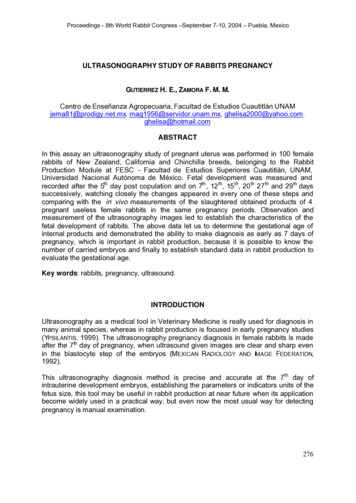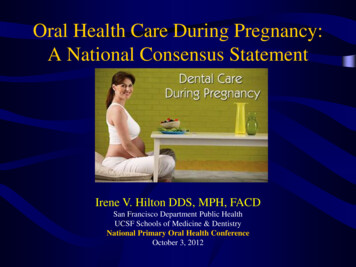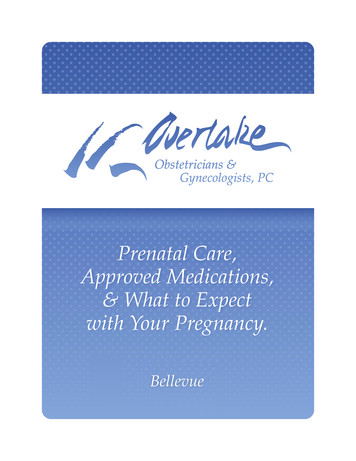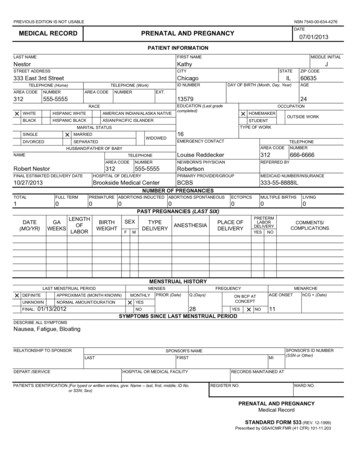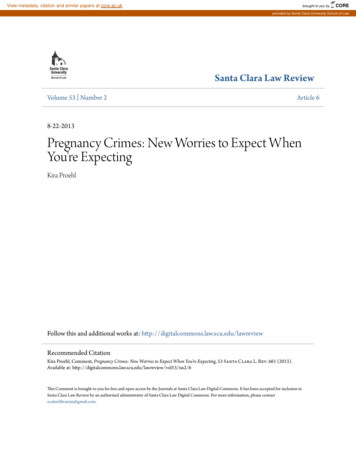
Transcription
View metadata, citation and similar papers at core.ac.ukbrought to you byCOREprovided by Santa Clara University School of LawSanta Clara Law ReviewVolume 53 Number 2Article 68-22-2013Pregnancy Crimes: New Worries to Expect WhenYou're ExpectingKira ProehlFollow this and additional works at: nded CitationKira Proehl, Comment, Pregnancy Crimes: New Worries to Expect When You're Expecting, 53 Santa Clara L. Rev. 661 (2013).Available at: iss2/6This Comment is brought to you for free and open access by the Journals at Santa Clara Law Digital Commons. It has been accepted for inclusion inSanta Clara Law Review by an authorized administrator of Santa Clara Law Digital Commons. For more information, please contactsculawlibrarian@gmail.com.
PROEHL FINAL7/23/2013 9:27 PMPREGNANCY CRIMES: NEW WORRIES TOEXPECT WHEN YOU’RE EXPECTINGKira Proehl*TABLE OF CONTENTSIntroduction. 662I. Categories of Pregnancy Crimes . 664A. Drug-Dependent Women: Regina McKnightand South Carolina . 664B. Prosecution for Defying Medical Orders. 6681. Refusing Cesarean Surgery: MelissaRowland and Criminal Prosecution . 6682. Refusing Cesarean Surgery: Jessie MaeJefferson and Civil Orders . 6693. Failing to Follow Doctor’s Orders: PamelaRae Stewart . 670C. Prosecution for Harm to Self: Bei Bei Shuai . 671D. Pregnancy Crimes: A Powerful Tool . 673II. Pregnancy Crimes as Violations of FundamentalRights . 673A. Due Process and the Requirement of FairNotice. 673B. Privacy in the Private Realm of the Family . 676C. Equal Protection. 678D. Are States Willing to Risk Serious Violations ofFundamental Rights? . 680III. Pregnancy Crimes Reflect Bad Policy . 680A. Slippery Slope: How to Properly Define “Good”and “Bad” Maternal Behavior . 681B. Difficulties in Determining “Unique Harm:”Panicked Science . 684C. Criminal Liability Creates Perverse Incentives . 687* J.D. Candidate, Santa Clara School of Law, 2013. I would like to thankthe Volume 53 Editorial Board of the Santa Clara Law Review for theircountless hours of hard work; Professor Michelle Oberman for her help inmaking this comment come to life; Lynn Paltrow, Farah Diaz-Tello, and EmmaKetteringham at the National Advocates for Pregnant Women for introducingme to the realities facing pregnant women; and Lynn Mumby, Tom Proehl, andJanna Proehl for their never ending love and support.661
PROEHL FINAL6627/23/2013 9:27 PMSANTA CLARA LAW REVIEW[Vol. 53D. Pregnancy Crimes and Policy: Conclusion . 690Conclusion . 690INTRODUCTIONIn 1984, Heidi Murkoff authored the first edition of Whatto Expect When You’re Expecting.1 Since then, she haspenned four more fantastically successful editions, whichhave sold over thirty-four million copies in the United Statesalone.2 The book has become one of the quintessentialsources for information about pregnancy throughout theworld.3 In 2012, it received the consummate American honor:a movie deal.4 Lionsgate turned it into a movie with JenniferLopez, Cameron Diaz, and Dennis Quade nestled amongst astar-studded ensemble cast.5 The enduring popularity of thefranchise is in part due to its exploration of a very basichuman impulse: a mother’s desire to birth and raise healthybabies.A pregnant woman and her fetus are inextricably linkedduring pregnancy.6 This knowledge drives women’s desire tounderstand the process and, consequently, the sales of Ms.Murkoff’s book. Everything from what a woman eats, whatshe breathes, and where she goes can influence the way afetus grows.7 Though many authors have weighed in on howa woman should act during pregnancy, historically theultimate decisions about how to behave have been left to themother. Recently, however, states have begun to regulate thebehavior of pregnant women through criminal statutes.1. About Heidi, WHAT TO EXPECT, aspx (last visited Oct. 7, 2012); ARLENE EISENBERG ETAL., WHAT TO EXPECT WHEN YOU’RE EXPECTING (2d ed. 1991).2. Id.3. See id.4. What to Expect When You’re Expecting, IMDB, http://www.imdb.com/title/tt1586265/ (last visited Oct. 7, 2012).5. What to Expect When You’re Expecting—the Movie!, WHAT TO the-movie.aspx (last visited Oct. 7,2012); What to Expect When You’re Expecting, supra note 4.6. See JERROLD S. GREENBERG, CLINT E. BRUESS & SARAH C. CONKLIN,EXPLORING THE DIMENSIONS OF HUMAN SEXUALITY 299 (4th ed. 2011).7. See infra Part III.A.
PROEHL FINAL2013]7/23/2013 9:27 PMPREGNANCY CRIMES663In 2005, there were an estimated six million pregnanciesin the United States.8 These pregnancies resulted in overfour million live births and just over one million fetal losses.9Twenty-six thousand of the fetal losses each year are due tostillbirths, defined as a loss of a fetus after twenty weeks ofgestation.10 Traditionally, stillbirths have been periods ofprivate mourning for a family. States across the politicalspectrum, from South Carolina to California, however, havestarted toying with the idea that these personal tragedies arematters of state concern. Utah, for example, enacted a law in2010 that criminalizes (via homicide) any pregnant womanwho “intentionally, [and] knowingly . . . causes the death of . . an unborn child at any stage of its development” except inthe context of a legal abortion.11 Every miscarriage andstillbirth in the state can potentially be subjected to acriminal investigation under this statute.12 When followed toits logical conclusion, such a law raises the question: to whatextent can the state regulate and control a pregnant woman’sbehavior in the effort to prevent stillbirths.This Comment will introduce these “pregnancy crimes,”which are really a new form of status crime aimed atpregnant women. In other words, the crimes can only applyto a very small, particular subset of the population. Part Iwill introduce various categories of pregnancy crimes thatprosecutors have already brought.13 It will focus on theprosecutions of drug-dependent women, women who defydoctors’ orders, and women who attempt self harm.14 Part IIwill discuss the laws behind pregnancy crimes and look athow these laws interact with the Due Process Clause, privacyconcerns, and the Equal Protection Clause.15 If states are8. Stephanie J. Ventura et al., Estimated Pregnancy Rates for the UnitedStates, 1990–2005: An Update, NAT’L VITAL STATISTICS REPORTS, Oct. 14, 2009,at 1.9. Id.10. Katherine Harmon, U.S. Stillbirths Still Prevalent, Often Unexplained,SCIENTIFIC AMERICAN (Dec. 13, 2011), http://www.scientificamerican.com/article.cfm?id stillbirth-risk-factors.11. UTAH CODE ANN. § 76-5-201 (West 2010).12. NAT’L ADVOCATES FOR PREGNANT WOMEN, SUBMISSION TO THE UNITEDNATIONS UNIVERSAL PERIODIC REVIEW 3 (2010).13. See infra Part I.14. See infra Part I.15. See infra Part II.
PROEHL FINAL7/23/2013 9:27 PM664SANTA CLARA LAW REVIEW[Vol. 53permitted to use existing murder and feticide laws to regulatea woman’s behavior during pregnancy, the rights of pregnantwomen will be severely impaired.16 Pregnancy crimes fail notonly under a constitutional analysis, but are also poorlyreasoned from a policy angle. Part III delves into the policyreasons behind pregnancy crimes.17 I find that holdingwomen criminally liable for the outcomes of their pregnancieswill actually serve to undermine the overarching state goal ofbirthing and raising healthy babies, particularly in high-riskpopulations, like drug-dependent women.18 Ultimately, ifpregnancy crimes are permitted to stand, pregnant womenwill become a new form of second-class citizen, with theirrights and liberties severely curtailed.I.CATEGORIES OF PREGNANCY CRIMESPregnancy crimes do not represent an academic idea, butan actual reality.19 Women have already been prosecutedthroughout the country for actions taken during pregnancy.It is estimated that at least two hundred women in more thanthirty states have been arrested and criminally charged foractions taken while they were pregnant.20 This section willintroduce a number of these prosecutions, separated intothree major categories: actions against drug-dependentwomen, prosecutions for failing to follow doctors’ orders, andprosecutions for self harm.A. Drug-Dependent Women: Regina McKnight and SouthCarolinaDrug dependency is a problem that afflicts people nomatter where they fall in the socioeconomic spectrum.2116. See infra Part II.D.17. See infra Part III.18. See infra Part III.D.19. See Ada Calhoun, The Criminalization of Bad Mothers, N.Y. TIMES, Apr.25, 2012, minalization-ofbad-mothers.html? r 1.20. CTR. FOR REPROD. RIGHTS, PUNISHING WOMEN FOR THEIR BEHAVIORDURING PREGNANCY: AN APPROACH THAT UNDERMINES WOMEN'S HEALTH ANDCHILDREN'S INTEREST 2 (2000) [hereinafter PUNISHING WOMEN], available proach-that-undermines-womens-heal.21. See Peter Kerr, Rich vs. Poor: Drug Patterns are Diverging, N.Y. 0/us/rich-vs-poor-drug-
PROEHL FINAL2013]7/23/2013 9:27 PMPREGNANCY CRIMES665However, only in the context of pregnant women hasdependency itself, as opposed to the possession or sale ofillicit substances, been subject to civil and criminal sanctions.States most often punish drug-dependent pregnant womenwith civil sanctions either by terminating parental rights orthrough child abuse statutes.22 However, in recent decades,criminal charges levied against women who take drugsduring pregnancy have been cropping up around thecountry.23 South Carolina, in particular, has taken a strongstance on the issue.More than five hundred women endure stillbirths inSouth Carolina each year,24 which is consistent with thenational average of around twenty-six thousand per year.25Many risk factors have been isolated, but often the root causeof a stillbirth is difficult to pinpoint.26 Historically, it hasbeen considered a personal tragedy, with families grieving inprivate.27 In 2001, however, a jury in South Carolina changedthe way stillbirths are viewed by the state when they occur inthe presence of drug dependency.28 The shift began with theprosecution of Regina McKnight, a developmentally disabledblack woman who lived in South Carolina, with her motherand three children.29 After her mother was killed in a hit andrun accident in 1998, Regina began to use drugs to cope withpatterns-are-diverging.html?pagewanted all&src pm.22. See Monica K. Miller, Refusal to Undergo a Cesarean Section: AWoman's Right or a Criminal Act?, 15 HEALTH MATRIX 383, 393 (2005).23. See generally PUNISHING WOMEN, supra note 20.24. David Guard, Press Release: South Carolina Supreme Court Reverses 20Year Homicide Conviction of Regina McKnight, STOPTHEDRUGWAR.ORG nches/2008/may/13/press release south carolina sup.25. Harmon, supra note 10.26. Loss and Grief, MARCH OF DIMES (Feb. 2010), http://www.marchofdimes.com/baby/loss stillbirth.html.27. See id.28. See Dana Page, Note, The Homicide by Child Abuse Conviction ofRegina McKnight, 46 HOW. L.J. 363, 363 (2003).29. Anne Gearan, Supreme Court Refuses to Hear Case Involving Stillbirth,THE SEATTLE TIMES, Oct. 7 2003, /?date 20031007&slug scotus07.; Sandy Banks, Crime and the Myth ofthe Perfect Mother, L.A. TIMES, May 27, 2001, at E1, E4; see also Bob Herbert,Op-Ed, Stillborn Justice, N.Y. TIMES, May 24, 2001, at A29 (saying people whoknew her believed she functioned at a level much lower than expected ofsomeone with an I.Q. of seventy-two).
PROEHL FINAL6667/23/2013 9:27 PMSANTA CLARA LAW REVIEW[Vol. 53her pain.30 A year later she was twenty-two years old,dependent on drugs, homeless, and pregnant.31When Regina McKnight went to Conway Hospital todeliver, a second tragedy struck, and she suffered astillbirth.32 She named the stillborn baby girl Mercedes33 andbegan to mourn her loss. This would typically be the end of amother’s public ordeal, but five months later, Regina wasarrested on charges of homicide by child abuse—a crimeunique to South Carolina. Unwittingly, Regina became avictim in the expansion of state laws to include fetuses aschildren with rights.South Carolina began targeting drug-addicted women forprosecution at the end of the 1980s.34 The State required“mandatory arrest of any woman who tested positive fordrugs after delivering a baby.”35 When this policy was firstimplemented, the Medical University of South Carolinatested women without their consent and disclosed anypositive results to the police, an arrangement ultimatelyfound to be unconstitutional.36 Black women in particular feltthe burden of this system.37Policy makers and hospitals were not the only groups inSouth Carolina working to implement fetal rights. Over thepast thirty years, South Carolina courts entered the fray andincluded viable fetuses within the definition of a humanbeing.38 In 1997, the state’s supreme court decided the case ofWhitner v. State,39 which constituted a giant step towardsestablishing independent rights of a fetus.40 In Whitner, a30. Gearan, supra note 29.31. Petition Filed Today Seeking U.S. Supreme Court Review ofUnprecedented South Carolina Decision Treating a Woman Who Suffered aStillbirth as a Murderer, NAT’L ADVOCATES FOR PREGNANT WOMEN (May es/prmcknight.htm[hereinafter Petition]; Page, supra note 28, at 365.32. Petition, supra note 31.33. Shalini Bhargava, Note, Challenging Punishment and Privatization: AResponse to the Conviction of Regina McKnight, 39 HARV. C.R.-C.L. L. REV. 513,516 (2004).34. See id. at 517.35. Id. at 517–18.36. Page, supra note 28, at 376–77.37. See id. at 378.38. Id. at 382–91.39. Whitner v. State, 492 S.E.2d 777 (S.C. 1997).40. Bhargava, supra note 33, at 518.
PROEHL FINAL2013]7/23/2013 9:27 PMPREGNANCY CRIMES667woman gave birth to a healthy newborn baby that testedpositive for cocaine.41 The court held that “the plain meaningof ‘child’ ” in its child abuse and endangerment statute“includes a viable fetus.”42 The dissent forcefully argued thatthe court was invading “the sole province of the legislativebranch,”43 and that the very language of the law precludes theinclusion of fetus in the definition of a child.44 Despite thedissent’s scorching criticism, women in South Carolina havebeen liable under civil statutes for their behavior during theirpregnancies since Whitner.This expansive definition of “child” has allowed SouthCarolina to bring the birthing process under scrutiny. SouthCarolina Code Section 16-3-85(A)(1) holds that if a personcauses the death of a child “while committing child abuse orneglect, and the death occurs under circumstancesmanifesting an extreme indifference to human life,” thatperson is guilty of homicide by child abuse.45 Regina wascharged under this statue.46 After a mistrial, she became thefirst woman in the United States to be convicted of homicideby child abuse for suffering a stillbirth.47 At twenty-fouryears old, she was given a twenty-year sentence, which waslater reduced to twelve years in prison.48On appeal in 2003, the Supreme Court of South Carolina,in a split opinion, held that a pregnant woman who heightensthe risk of a stillbirth, even unintentionally, could be found41. Whitner, 492 S.E.2d at 778.42. Id. at 785.43. Id. at 787 (Moore, J., dissenting).44. Id. at 788 (“Contrary to the majority's strained analysis in this case, oneneed look no further than the language of § 20–7–50 to clearly discernlegislative intent that the statute apply only to children in being. ‘Legalcustody’ is not a qualification applicable to a viable fetus. I simply disagree thelegislature intended a statute entitled ‘Unlawful neglect of child or helplessperson by legal custodian’ to render a pregnant woman criminally liable for anytype of conduct potentially harmful to the unborn fetus.”).45. S.C. CODE ANN. § 16-3-85(A)(1) (2003); State v. McKnight, 576 S.E.2d168, 172–73 (S.C. 2003).46. See McKnight, 576 S.E.2d at 172.47. Bhargava, supra note 33, at 513; see also Regina McKnight—Victory atLong Last, NAT’L ADVOCATES FOR PREGNANT WOMEN (May 12, 2008, 3:14 /05/regina mcknight victory atlon.php.48. Bhargava, supra note 33, at 513; McKnight, 576 S.E.2d at 171.
PROEHL FINAL6687/23/2013 9:27 PMSANTA CLARA LAW REVIEW[Vol. 53guilty of “extreme indifference to human life.”49 This broaddecision allows for any woman who engages in an activity“public[ly] know[n]” to be “potentially fatal” to a fetus to beheld civilly and criminally liable.50 Regina appealed her caseand in 2008, the Supreme Court of South Carolina found thatMcKnight had been offered ineffective assistance from herappointed counsel.51 The court also acknowledged that therewas a reasonable probability that the jury relied on the“adverse and apparently outdated scientific studiespropounded by the State[] . . . that cocaine caused the deathRegina’s sentence was suspended, butof the fetus.”52criminal liability for pregnancy remains on the books inSouth Carolina.B. Prosecution for Defying Medical OrdersDrug dependency is not the only situation leading to amother’s liability for actions taken during pregnancy. Manystates have attempted to prosecute women for defying theirdoctors’ orders.This section will outline two frequentinstances when women have chosen paths deviating fromtheir physician’s suggestions, and which, as a result, have ledto legal troubles. The first two sections will discuss refusalsof cesarean surgeries and the third will delve into failing tofollow doctors’ orders while at home.1. Refusing Cesarean Surgery: Melissa Rowland andCriminal ProsecutionMelissa Rowland was sent to a mental hospital when shewas twelve years old.53 She had been suicidal at severalpoints in her life.54 At age fourteen, she gave birth to her firstset of twins.55 She later became pregnant with her second set49. See McKnight, 576 S.E.2d at 172–73.50. See id. at 173.51. McKnight v. State, 661 S.E.2d 354, 359 (S.C. 2008).52. Id. at 360–61.53. Alexandria Sage, Utah C-Section Mom Gets Probation, CBSNEWS (May7, 2009, 1:34 PM), /main605537.shtml.54. See Katha Pollitt, Pregnant and Dangerous, THE NATION (Apr. 8 d-dangerous.55. Id.
PROEHL FINAL2013]7/23/2013 9:27 PMPREGNANCY CRIMES669of twins and her boyfriend abandoned her.56 When she wentto the hospital in Salt Lake City for delivery, she initiallydeclined a recommended cesarean surgery.57 She eventuallychanged her mind and submitted to the operation on January13, 2004.58 One twin, her daughter Hannah, survived, butthe twin boy did not.59 Hannah tested positive for cocaine.60With no time to mourn her loss, Melissa was charged withfirst-degree murder for the death of her stillborn son, takenaway from her children, and sent to jail.This was the first reported case of a criminal prosecutionbrought against a mother, in part, for refusing to undergocesarean surgery.61 The proceedings were soon engulfed incontroversy and a national dialogue broke out concerning themerits of forcing a woman into surgery against her will.62Cesarean surgery is a major event that can cause lastingcomplications for the mother.63 Groups began debating thehigh rate of cesarean surgery in the United States and thebalance of rights between a mother and her fetus.64 Afterthree months behind bars, the prosecution relented andMelissa accepted a plea to two counts of child endangermentfor using drugs during pregnancy.65 The murder chargerelated to the refusal of the cesarean section was dropped.662. Refusing Cesarean Surgery: Jessie Mae Jefferson andCivil OrdersDrug-dependent women are not the only subset of thepopulation threatened with legal action for refusing to submitto cesarean surgery. In the case of Jessie Mae Jefferson, itwas the patient’s religious convictions that Georgia chose tooverride. When Jessie was due to deliver her child, she was56. Id.57. See Miller, supra note 22, at 383.58. Lisa Collier Cool, Could You Be Forced to Have a C-Section?, dvocatesforpregnantwomen.org/articles/forced c-section.htm.59. Id.60. Pollitt, supra note 54.61. Miller, supra note 22, at 384.62. See Pollitt, supra note 54.63. Miller, supra note 22, at 385.64. See Cool, supra note 58.65. Id.66. Id.
PROEHL FINAL6707/23/2013 9:27 PMSANTA CLARA LAW REVIEW[Vol. 53diagnosed with a complete placenta previa.67 This left herchild with a ninety-nine percent chance of dying in a normalbirth and placed the odds of her own survival at only fiftypercent.68 Doctors informed her that she and her child werevirtually guaranteed to survive a cesarean surgery.69 Despitethese odds, Jessie and her husband followed their religiousbeliefs and insisted on continuing with a natural birth.70Griffin Spalding County Hospital responded by seekingan order from the Butts County Superior Court that wouldrequire Jessie to deliver her child through cesarean surgeryand accept any necessary blood transfusions.71 The order wasgranted72 and the court gave temporary custody of the fetus—still inside of Jessie’s body—to the Georgia Department ofHuman Resources.73 The state supreme court refused to staythe motion, and plans were made to compel Jessie to undergoan unwanted surgery.74 At the last moment, this drasticmeasure proved unnecessary. Jessie’s placenta shifted andshe was able to give birth without intervention.75 Precedentat the hospital and in the courts, however, was set.3. Failing to Follow Doctor’s Orders: Pamela RaeStewartCaesarean surgeries are not the only points of contentionbetween pregnant women and their doctors. There have beencases of women being criminally charged for failing to followother doctor-recommended treatment. One such dispute tookplace in California. Pamela Rae Stewart was the mother oftwo children.76 She and her husband frequently moved from67. Jefferson v. Griffin Spalding Cnty. Hosp. Auth., 274 S.E.2d 457, 458(Ga. 1981). Placenta previa is “[a] placenta which is attached to the lower partof the interior of the uterus . . . so that it partly covers the outlet of the uterus.”J.E. SCHMIDT, SCHMIDT’S ATT’YS DICTIONARY OF MED. 205 (1991).68. Jefferson, 274 S.E.2d at 458.69. See Brent T. Stanyer, Court-Ordered Cesarean Sections: An Example ofthe Dangers of Judicial Involvement in Medical Decision Making, 28 GONZ. L.REV. 121, 123 (1992).70. Jefferson, 274 S.E.2d at 459; Stanyer, supra note 69, at 123.71. Stanyer, supra note 69, at 122.72. Jefferson, 274 S.E.2d at 460.73. Stanyer, supra note 69, at 123.74. Id. at 123–24.75. Id. at 124.76. Lee A. Schott, The Pamela Rae Stewart Case and Fetal Harm:Prosecution or Prevention?, 11 HARV. WOMEN’S L.J. 227, 227 (1988).
PROEHL FINAL2013]7/23/2013 9:27 PMPREGNANCY CRIMES671job to job in an attempt to support their family.77 In 1985 shebecame pregnant with her third child.78 Eight months later,she, too, was diagnosed with placenta previa.79 The doctorssent Pamela home with strict instructions to stay off her feetand avoid sexual intercourse.80 On November 23, she had sexwith her husband and soon began to bleed, sending her to thehospital.81 Doctors later concluded that the bleeding causedher son, Thomas Monson, Jr., to be brain dead at birth.82 Hedied five weeks later.83Nine months after her son’s death, Pamela was arrestedand charged under California Penal Code Section 270, acriminal child neglect statute that expressly covers fetuses.84The charge was based on her alleged use of drugs, herengagement in intercourse, and her alleged failure topromptly go to a hospital when the bleeding started.85 OnFebruary 26, 1987, the San Diego Municipal Court Judgesustained a demurrer from the defense finding that Section270 “was not intended to apply to this situation and does notimpose a duty upon the pregnant woman.”86 He left open thechance that a more narrowly tailored law could apply.87C. Prosecution for Harm to Self: Bei Bei ShuaiIn no state is suicide a statutory crime.88 However, anIndiana court is currently deciding a case that presents thenovel question of whether a pregnant woman who attemptssuicide should be criminally accountable for the subsequentharm to her fetus. At the time of the incident, Bei Bei Shuai77. See id.78. Id.79. Id. at 228.80. Id.81. Id.82. Id. at 229.83. See id.84. Id.85. See Miller, supra note 22, at 395.86. Schott, supra note 76, at 230.87. See id.88. .suicidefindinghope.com/content/is suicide a crime (last visited Oct.9, 2012) [hereinafter Suicide]; see also Wackwitz v. Roy, 418 S.E.2d 861, 864(Va. 1992).
PROEHL FINAL6727/23/2013 9:27 PMSANTA CLARA LAW REVIEW[Vol. 53was thirty-four years old and living in Indiana.89 She and herboyfriend had opened a Chinese restaurant together and thetwo soon conceived a child.90 When Bei Bei was in her thirdtrimester, her boyfriend informed her that he was actuallymarried to another woman and was ending the relationshipwith Bei Bei.91 He left Bei Bei crying on her knees in aparking lot.92 Traumatized and alone, she decided to end herlife by ingesting rat poison (which, incidentally, is one of theslowest and most excruciating ways to die).93 When the pillsdid not immediately take effect, she drove to a gas stationwhere she encountered a friend.94 He brought her home tohis wife and in their effort to determine the nature of BeiBei’s illness, the couple eventually learned about the poison.95They immediately took Bei Bei to a hospital where she wastreated and survived.96Several days later Bei Bei’s daughter, Angel, was bornthrough a cesarean surgery.97 The baby survived birth, butdied days later in the arms of her distraught mother.98 Aftera few months, Bei Bei was charged with murder and feticideand put in jail.99 The trial court denied Bei Bei’s motion forbail on June 6, 2011, although the Appellate Court lateroverruled the motion.100 However, the same Appellate Courtruled that Indiana’s murder and feticide statute could beapplied to these circumstances.101 At the time of this writing,89. Jennifer Block, Jailed for a Suicide Attempt, THE DAILY BEAST (Apr. 12,2011, 10:32 PM), l.90. Id.91. Bei Bei Shuai v. State, 966 N.E.2d 619, 622 (Ind. Ct. App. 2012).92. Block, supra note 89.93. Lynn M. Paltrow, Is Locking Up Pregnant Women the New Cure forState Financial Woes and Mental Health Problems?, THE HUFFINGTON shuai b 842753.html[hereinafterPaltrow].94. Block, supra note 89.95. See id.96. Paltrow, supra note 93.97. Block, supra note 89.98. Id.99. See Paltrow, supra note 93.100. Bei Bei Shuai v. State, 966 N.E.2d 619, 632 (Ind. Ct. App. 2012).101. Id. at 629 (“The State alleged the existence of facts that could satisfy theelements of murder: Shuai is a ‘person,’ the State alleged she intended to killA.S. by virtue of Shuai's mention of the fetus in the suicide note, and the victim
PROEHL FINAL2013]7/23/2013 9:27 PMPREGNANCY CRIMES673the case is currently pending trial.D. Pregnancy Crimes: A Powerful ToolThese cases illustrate the potential for a sharp disparitybetween the wishes of the mother and the state and themeans each party has to exert their will. States throughoutthe country have resorted to criminal law to gain enoughleverage to force women to adhere to their doctors’ orders.This Article divides pregnancy crimes into three separatecategories, but in reality, the lines are much more blurred.The resounding theme in these cases is that poor women withlittle resources are being threatened with and sent to prisonbecause of actions they take during their pregnancies. Theirprosecution leads not only to bad laws, but also to badpolicies. The next part of this Comment will critique the legalanalysis underlying these diverse cases.II. PREGNANCY CRIMES AS VIOLATIONS OF FUNDAMENTALRIGHTSPregnancy crimes are based on a misguidedinterpretation of the law. Expanding the reach of murder,feticide, and criminal child endangerment statutes to reachthe relationship between a woman and her fetus encroacheson many of the woman’s rights. This section will specificallyfocus on issues born of the failure to provide fair noticerequired by the Due Process Clause, privacy concerns, andequal protection.A. Due Process and the Requirement of Fair NoticeThe United States Supreme Court has ruled that a law“fails to meet the requirements of the Due Process Clause if itis so vague and standardless that it leaves the publicA law isuncertain as to the conduct it prohibits.”102impermissibly vague when it fails to establish sufficient lawenforcement standards that protect against an arbitrarywas an entity protected under the murder statute, be it a ‘viable fetus’ or‘human being,’ died. Nor can we find the feticide statute ambiguous as appliedhere, as it is undisputed Shuai's pregnancy was terminated when A.S. was b
to Expect When You’re Expecting.1 Since then, she has penned four more fantastically successful editions, which have sold over thirty-four million copies in the United States alone.2 The book has become one of the quintessential sources for information about pregnancy throughout the wo
